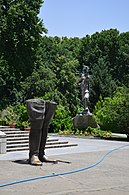Saadabad Palace
The complex includes natural forest, streets, qanats, galleries, mansions/palaces and museums.
History
The complex was initially built and inhabited in the 19th century by the Qajar shahs. After extensive expansions, Reza Shah of the Pahlavi dynasty resided there from the 1920s until his exile in 1941. His son, Mohammad Reza Shah, moved there in the 1970s. In 1978, President Jimmy Carter stayed in the palace during a visit to Iran to guarantee U.S. support for the regime. After the 1979 Revolution, the complex became a public museum.
Present use
Large parts of the complex are museums, which are accessible to visitors. Other parts are currently used by the Office of the President of the Islamic Republic of Iran. The complex is operated by the Cultural Heritage Organization of Iran.
Sites
Gates to the complex
- Nezamie Gate, from which Reza Shah would enter the complex.
- Zaferanie Gate, Currently used by the presidency organization.
- Gate of Darband Street, from which Mohammad Reza Shah would enter the complex.
- Gate of Darband Square
- Ja'far Abad Gate (1st)
- Ja'far Abad Gate (2nd)
- River Gate
- The White House Gate
Main buildings


- Ahmad Shah Qajar Palace
- (not to be confused with the Pavilion of Ahmad Shah Qajar in the Niavaran Complex)
- The Green Palace
- (also known as the Shahvand House)
- The Mellat Museum
- The White Palace, former official residence of Shah Mohammad Reza Shah and Shahbanu Farah.
- Museum of Natural History
- The Special Palace, currently used by the presidency organization.
- Museum of Fine Arts
- The Black Palace
- Museum of Anthropology
- Princess Shams' Palace, named after Shams Pahlavi.
- Museum of Glassware and Handicrafts
- Princess Ashraf's Palace, named after Ashraf Pahlavi.
- Building of the Amendment 36 (a governmental agency)
- Prince Gholam Reza's Palace, named after Gholam Reza Pahlavi.
- Palace of the King's Mother
- Currently used by the presidency organization.
- Prince Ahmad Reza's Palace, named after Ahmad Reza Pahlavi.
- Currently used by the presidency organization.
- Administration of the complex
- Prince Abdol Reza's Palace, named after Abdul Reza Pahlavi.
- The Training Center
- Prince Bahman's Palace, named after Gholam Reza Pahlavi's son.
- The Military Museum
- Prince Shahram Palace, named after Ashraf Pahlavi's son.
- Museum of Artistic Creatures
- Palace of Farideh Ghotbi, mother of Shahbanu Farah.
- The Behzad Museum
- 1st Palace of Reza Pahlavi, named after Crown Prince Reza Pahlavi.
- Museum of Treasure (The Dafine Museum)
- 2nd Palace of Reza Pahlavi, currently used by the presidency organization.
- Museum of Mir Emad Calligraphy
- Palace of Princess Farahnaz and Prince Ali Reza, named after Farahnaz Pahlavi and Ali Reza Pahlavi.
- The Abkar Museum
- Princess Leila's Palace, named after Leila Pahlavi.
Palace of the King's Mother
During the Pahlavi era, this palace was the place of the last years of Reza Shah's life before his exile to Mauritius. It was also the place of residence of the king's mother (Taj al-Muluk) until the time of the 1979 Revolution.
This palace is currently in the possession of the Presidential Institution of Iran and is reserved for special guests of the Government of Iran; and for this reason it is also famous as "The Republic Building". This palace is also currently inaccessible to the public.
The Green Palace
The Green Museum Palace has been called "the most beautiful palace in Iran". This palace is important due to its historical and architectural importance. It dates back to the Qajar period and has two styles of Iranian architecture. They called this palace "The Stone Palace" during the reign of Reza Khan and "The Shahvand palace" during the reign of Mohammad Reza Pahlavi; later, it was called "The Green Palace" because of its green façade.
The Mellat Museum
The Palace of the Nation Museum with an area of 7,000 square meters is the largest palace in Sa'dabad complex.
Until after the 1979 revolution and the transfer of the complex to the Cultural Heritage Organization, it was renamed "The Palace of the Nation Museum" (Mellat museum in Persian). The construction of the Palace, began in the late Pahlavi period.
Gallery
-
Statue of the Shah's Legs
-
The Green Palace
-
The White Palace
-
Princess Shams' Palace
-
Prince Bahman's Palace
-
Side view of the Green Palace
-
Mirror Hall of the Green Palace
-
Section of the Royal Cars
-
Museum of the Royal Clothes
-
Section of Reza Shah's clothes
-
Sa'adabad Gate
-
Personal desk
See also
- Niavaran Complex
- Treaty of Saadabad
- Pahlavi Iran
- Pahlavi dynasty
- Iranian architecture
- Presidential palace
References
- ^ Collins, N.W. (2021). Grey wars : a contemporary history of U.S. special operations. New Haven. ISBN 978-0-300-25834-9. OCLC 1255527666.
{{cite book}}: CS1 maint: location missing publisher (link) - ^ "Sa'dabad Complex | A Tehran's most beautiful historical attraction!". ir Persiatour. 18 May 2022. Archived from the original on 7 June 2022. Retrieved 7 June 2022.
- ^ "Sa'dabad Complex | A Tehran's most beautiful historical attraction!". ir Persiatour. 18 May 2022. Archived from the original on 7 June 2022. Retrieved 7 June 2022.













